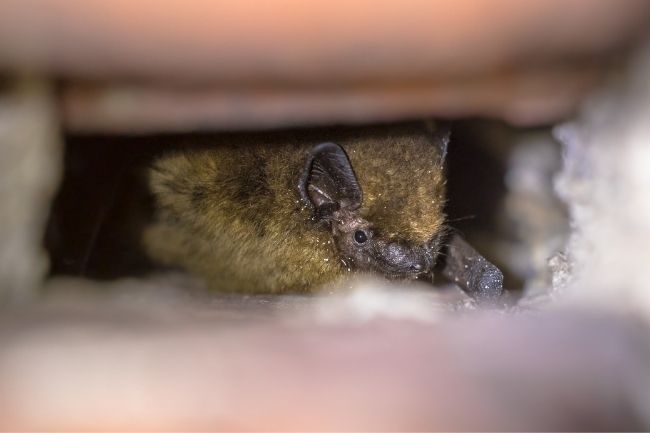Some millipedes do enter a state that is similar to hibernation. True hibernation is experienced by warm-blooded animals, whereas millipedes enter diapause. They may also enter aestivation, which is similar but occurs during dry periods.
Contents
What is hibernation?

Hibernation is often thought of as just a big sleep. While it may appear as though a hibernating animal is sleeping, they have actually entered a very different state. Hibernation involves a series of physiological changes that occur within an animal. This includes their body temperature dropping, heart-rate slowing and metabolism decreasing.
All of these changes allow the animal to get through a tough period without needing as much food, and survive temperatures that would normally result in their deaths. One of the most famous hibernators is the bear. Bears eat large amounts during the summer and autumn, helping them to pile on the weight. During the winter, these fat reserves then allow them to hibernate through the lean times.
Although animals may be said to hibernate through the whole winter, many animals go in and out of deep hibernation. This allows them to eat or go to the toilet. Some species store food with them within their burrows or nests.
While hibernation may largely be to get animals through winter, some species also need to sit out particularly hot or dry periods. This is referred to as aestivation. Worms are well-known for entering aestivation during dry periods. During the summer, they may move deep down within the soil and curl into a ball, covering themselves in a kind of mucus. This helps to them to stay wet, which is important to keep them healthy.
What happens to millipedes in the winter?

There are over 12,000 different species of millipedes across the world. Millipedes have adapted to live in many different habitats, from deserts to rainforests to temperate grasslands. Like most cold-blooded animals, they need warmth in order to function. This means that freezing conditions can cause to them to die.
For those species that live in hot and tropical areas, colder temperatures aren’t much of a concern. Many of these species won’t need to hibernate at all and can keep active throughout the year.
| Survival Strategy | Description |
|---|---|
| Hibernation | Some millipede species enter a state of hibernation during the winter months |
| Burrowing | Millipedes may burrow into the ground to escape the cold and maintain more stable conditions |
| Moisture Conservation | They conserve moisture by reducing activity and minimizing water loss |
| Slow Metabolism | Millipedes decrease their metabolic rate to conserve energy and survive with limited food |
Those species that live in temperate areas have to find ways to survive the cold. Due to the type of food millipedes eat, they spend a lot of their time within or under rotting materials. As plant matter rots, it gives off a certain amount of heat. This can mean they stay more active than species that are moving above the ground.
When temperatures do drop too low for comfort, millipedes can enter a state similar to hibernation, known as diapause. Insects and other cold-blooded animals are said to enter diapause rather than hibernate, as they do not go through the same physiological changes as warm-blooded animals do, such as their body temperature dropping.
It is most-likely that millipedes tuck themselves away somewhere sheltered and hidden, such as in a burrow or underneath a log, in order to enter diapause. Many arthropod species that enter diapause may emerge to feed if temperatures temporarily rise.
| Behavior | Description |
|---|---|
| Clustering | Millipedes may cluster together in groups to benefit from shared body heat and provide protection |
| Shelter Seeking | They actively seek out sheltered areas such as leaf litter, logs, or underground tunnels |
| Reduced Movement | Millipedes exhibit reduced movement during winter to conserve energy and avoid exposure to the cold |
| Reproduction Pause | Some millipede species halt reproduction during winter and resume breeding activities in spring |
Not all millipedes may get through the winter in this way, however. Some species only live a year, meaning that they probably die once temperatures drop. The next generation is however safely tucked away in the soil, in the form of eggs or juveniles.
Also read: Millipede Life Cycle – Reproduction, Lifespan & More!
Aestivation
Millipedes spend most of their time in damp, dark places. This is in part because they easily dry up. Because of this, millipedes do not tend to live in dry habitats, with the exception of some species such as the desert millipede.
Some species have been found to enter aestivation when the conditions become too dry. Aestivation is very similar to diapause, the main difference being that this occurs during dry periods rather than in cold periods. The African giant millipede is thought to enter aestivation during drier periods in its natural habitat.
Busy little millipedes
Like many smaller animals, millipedes have a very careful balance to strike. Too much time sleeping their time away, and they will miss out on vital food and feeding opportunities. However, if they don’t heed the conditions, they could quite easily get caught out by the changing conditions and either freeze to death or dry up entirely.
Even with the optimum planning, sheer bad luck could see them ending their days frozen into an icicle or in the belly of a scavenging animal. It’s certainly not an easy life being a millipede, even with all those many pairs of legs to help them along.

